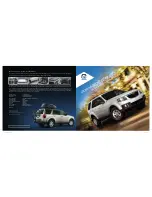
04 Comfort and driving pleasure
Adaptive Cruise Control (ACC)*
04
164
*
Option/accessory, for more information, see Introduction.
Introduction
Adaptive Cruise Control (ACC) is an optional
system designed to assist the driver by main-
taining a set speed or a set time interval to the
vehicle ahead. It is primarily intended for use
on long straight roads in steady traffic, such as
on highways and other main roads.
When the driver has set the desired speed and
the time interval to the vehicle ahead, ACC
functions as follows:
•
If there are no other vehicles in the lane
ahead of you, your vehicle will travel at the
set speed.
•
If ACC's radar sensor detects a slower
moving vehicle in the lane ahead, the sys-
tem will adapt your vehicle's speed to help
maintain the set time interval to the vehicle
ahead. When there are no longer slower
moving vehicles ahead, your vehicle will
accelerate to resume the set speed.
If ACC is switched off completely or in standby
mode and your vehicle comes too close to
another vehicle ahead, the driver will be
warned by the Distance Alert system (see
page 173).
WARNING
•
Adaptive Cruise Control cannot cover
all driving situations and traffic, weather
and road conditions. The "Function"
section provides information about lim-
itations that the driver must be aware of
before using this feature.
•
This system is designed to be a supple-
mentary driving aid. It is not, however,
intended to replace the driver's atten-
tion and judgement. The driver is
responsible for maintaining a safe dis-
tance and speed and must intervene if
Adaptive Cruise Control does not main-
tain a suitable speed or suitable dis-
tance to the vehicle ahead.
•
Maintenance of ACC components may
only be performed by a trained and
qualified Volvo technician.
Function
Function overview
Warning light, braking by driver required
Controls in steering wheel
Radar sensor in front grille
Adaptive Cruise Control consists of:
•
A cruise control system to maintain a set
speed
•
A system to maintain a set distance to the
vehicle ahead, which is expressed as a
time interval. For example, you can choose
to remain approximately 2 seconds behind
the vehicle ahead. The actual distance
required to maintain a 2-second interval
will vary according the speed of the vehi-
cles.
Summary of Contents for 2010 XC60
Page 1: ...VOLVO XC60 Owner s Manual Web Edition ...
Page 2: ......
Page 7: ...Contents 7 09 09 Index Index 316 ...
Page 15: ...SAFETY ...
Page 53: ...01 Safety 01 53 ...
Page 54: ...54 Remote key and key blade 56 Keyless drive 63 Locks 66 Alarm 69 ...
Page 55: ...LOCKS AND ALARM ...
Page 71: ...02 Locks and alarm 02 71 ...
Page 73: ...YOUR DRIVING ENVIRONMENT ...
Page 74: ...03 Your driving environment Instruments and controls 03 74 Instrument overview ...
Page 123: ...03 Your driving environment 03 123 ...
Page 125: ...COMFORT AND DRIVING PLEASURE ...
Page 205: ...04 Comfort and driving pleasure Passenger compartment convenience 04 205 Storage spaces ...
Page 209: ...04 Comfort and driving pleasure 04 209 ...
Page 211: ...DURING YOUR TRIP ...
Page 233: ...05 During your trip 05 233 ...
Page 235: ...WHEELS AND TIRES ...
Page 263: ...06 Wheels and tires 06 263 ...
Page 265: ...MAINTENANCE AND SPECIFICATIONS ...
Page 287: ...07 Maintenance and specifications Fuses 07 287 Engine compartment ...
Page 299: ...07 Maintenance and specifications 07 299 ...
Page 301: ...SPECIFICATIONS ...
Page 302: ...08 Specifications Label information 08 302 Location of labels ...
Page 315: ...08 Specifications 08 315 ...
Page 324: ...09 Index 09 324 ...
Page 325: ......
Page 326: ...Kdakd 8Vg 8dgedgVi dc IE JH6 8VcVYV 6I Eg ciZY c HlZYZc iZWdg 8deng i Kdakd 8Vg 8dgedgVi dc ...
















































